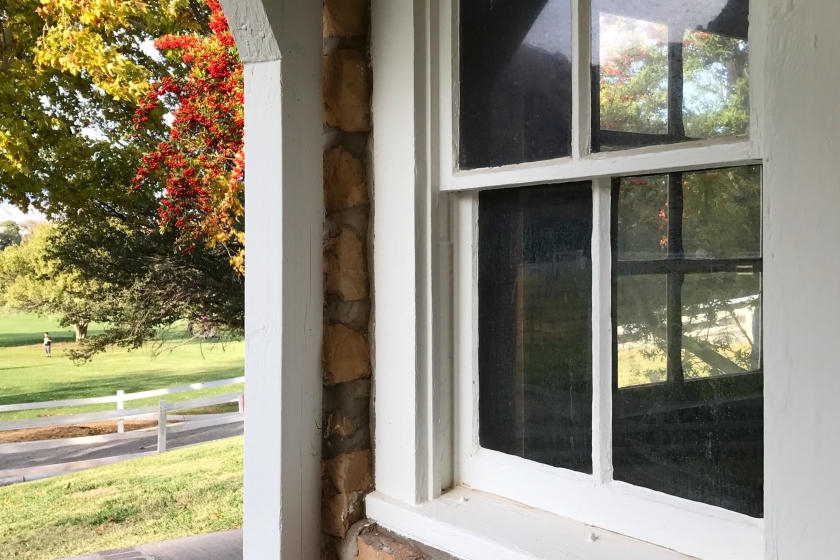Wood trim around exterior windows and doors can begin to wear, warp and rot over time. This can not only look bad, but trim in disrepair can allow water to get underneath and create further damage. While the elements will take their toll, you can make repairs to or even replace wood trim without the need for expensive professional help.
Step 1: Check Trim Condition
Take a walk around your home and inspect your windows, doors or anywhere else where there is wood trim. Look for cracks, holes, and damaged, loose, or rotting wood. Determine whether you can repair the wood, if you will need to replace individual pieces, or need to replace all of the trim around a window or door.
Step 2: Make Repairs
If the wood isn’t rotting, excessively warped or otherwise badly damaged, you can simply make a few quick repairs to bring trim back to its original attractive and sound condition. If a piece of trim is loose, use a hammer and nails to refasten it to the wall.
Cracks between the trim and the wall can be filled with silicone caulk. Remove old caulk, paint and debris from the crack with a putty knife, painter’s 5-in-1 tool or another similar tool. Go over the crack a couple of times with a wire brush to remove remaining debris.
Helpful Tip
Watch the weather. Weather can affect the long-term performance of caulks, so only apply it when the temperature is between 50 and 90 degrees Fahrenheit. Don’t apply caulk when it’s raining or snowing.
Use a utility knife to cut the nozzle of the caulk tube at a 45-degree angle, and place it in a caulking gun. As you apply the caulk, hold the caulking gun at a 45-degree angle parallel to the joint being filled. Position the nozzle opening so that it forces sealant onto the joint surfaces. Smooth out, or “tool”, the applied bead of caulk to force the caulk into the crack and to ensure proper sealing. Use a latex-gloved finger or a foam paintbrush to smooth the caulk. Keep rags handy to clean up any mishaps and clean up any problem areas right away, since it is much more difficult to clean up dried caulk later. Consult the manufacturer’s instructions for curing times.
Use exterior wood filler to fill and patch cracks in the trim itself as long as it is still structurally sound. First, rough up the surface with coarse sandpaper to ensure a good bond. Then apply wood filler with a putty knife. When it’s hard and dry, sand it level with a medium- or fine-grit sandpaper.
Loose, flaking paint on the trim should be removed with a paint scraper. Other dents, nicks and scratches can be removed by sanding. For best results, use sandpaper on a rubber sanding block or a sanding sponge. Start by sanding with 80-grit paper until the dent or scratch is smooth, then finish, sand and feather into the surrounding area with 120-grit paper. Wipe the area clean with a slightly damp rag to remove dust and grit.
Step 3: Replace Trim
Rotted and damaged wood trim needs to be replaced. Measure each piece of trim to be replaced and write down the dimensions. You will need to cut a new piece of trim to fit and you need to get a matching piece of wood. When you buy new pieces of trim, be sure you add a few additional inches to the length so that you have room for making errors in your cuts.
Remove the damaged trim using a pry bar, screwdriver or the claw of a hammer. Use a miter saw to cut the new trim pieces with the measurements you took of the old pieces. Place a piece of trim face up against the saw fence and position it so that your measurement marks are aligned with the blade and then turn the blade to a 45-degree angle and make your cut. Do this on the other end of the piece of trim and make the cut at a 45-degree angle that is opposite the first cut. The angles you cut in the new piece of trim need to correspond with the existing trim so that the new piece fits with the rest and complete a square corner.
Safety Alerts!
When operating power tools, such as saws, read all manufacturers’ instructions carefully before use.
Don’t wear loose clothing, over-sized gloves, jewelry or any accessories that can get caught within the spinning blades of the miter saw. In addition, long hair should be pulled back.
Use a hammer and nails to attach the new trim in place. To get the head of the nails below the surface, use a nail set and hammer to sink them in. Cover the holes with wood putty as you would in Step 2.
Step 4: Prime and Paint Trim
Use drop cloths to cover the ground so you don’t get paint on walkways, shrubbery or your yard. Remove screens, light fixtures, or anything else that might get splattered or cover them with painter’s tape before you begin. Painter’s tape should also be used to protect the edges where the trim meets the siding or brick of your wall.
Use high-quality enamel or varnish brushes. They hold more paint, apply with ease and don’t leave brush strokes. Choose brushes with flagged tips and tapered edges. Small, angular-tipped brushes are good for working on any small, hard-to-reach areas in corners and for detail work. You can use a larger brush for the main part of the trim.
Prime the trim with True Value EasyCare Ultra Premium Exterior Primer/Sealer and paint with True Value EasyCare Ultra Premium Exterior Paint. Apply one coat, or two if necessary, using a small paintbrush. Use a ladder to prime and paint trim that is out of reach. Let each coat dry thoroughly (overnight, if possible) before continuing.
Safety Alert!
Familiarize yourself with basic ladder safety procedures.
Load your brush by covering 1/3 to 1/2 of the bristles and tap the brush on the side of the can to remove any excess paint. Apply from one side of the brush with one long stroke. Use the return trip to unload the other side, starting just where the first stroke ended. Complete each area with a long, light finishing stroke. Make sure to brush toward the paint that was just applied each time you begin a new stroke. To get the best results, paint only a few feet of trim or molding at a time. Clean up any drips or splatters before they dry.
That’s it! You’re done. Your exterior trim is repaired, refreshed and revitalized.
Project Shopping List
Here’s what you’ll need to complete this project successfully.
- Hammer
- Nails
- Silicone caulk
- Putty knife, 5-in-1 painter’s tool or similar tool
- Wire brush
- Utility knife
- Caulking gun
- Latex gloves
- Foam paintbrush
- Rag or old towel
- Exterior wood filler
- Sandpaper: course, medium-grit, fine-grit
- Paint scraper
- Rubber sanding block
- Sanding sponge
- Trim lumber
- Pry bar or screwdriver
- Miter saw
- Nail set
- Plastic or canvas drop cloths
- Painter’s tape
- Enamel or varnish brushe
- EasyCare Ultra Premium Exterior Primer/Sealer
- EasyCare Ultra Premium Exterior Paint
- Ladder












